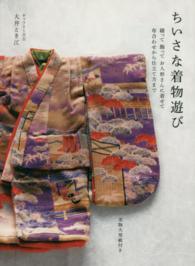Full Description
This volume is an investigation and classification of dialects along the Wu and Jiang-Hwai Mandarin border in China's eastern Yangtze Valley. It is the first monograph-length study to critically question the traditional single criterion of initial voicing for the classification of Wu dialects and propose a comprehensive comparative framework as a more successful alternative. Arguing that dialect affiliation is best determined through analysis of dialect correspondence to common phonological systems, the author develops a taxonomic analysis that definitively distinguishes Common Northern Wu and Mandarin dialects. By clarifying dialect affiliation in the Wu and Mandarin border region, this volume makes significant contributions to our understanding of the true nature of the region's dialects and their history.
Using primarily data drawn from the author's own fieldwork, the volume contains copious comparative examples and an extensive lexicon of the Old Jintarn dialect.
Contents
1. Acknowledgments; 2. Introduction; 3. Map; 4. Chapter 1: The Problem of Harngjou; 5. 0. Brief background; 6. 1. The Mandarin nature of Harngjou phonology; 7. 2. The Mandarin nature of Harngjou lexicon; 8. 3. Harngjou's Wu-like tendencies; 9. Chapter 2: Identifying Wu Dialects; 10. 0. The goal; 11. 1. Some previous definitions of Wu dialect affiliation; 12. 2. Classifying Wu dialects by reference to a common phonology; 13. 3. The problems with Chiehyunn based classification; 14. Chapter 3: Common Northern Wu; 15. 0. Preliminaries; 16. 1. Common initial categories; 17. 2. Common tone categories; 18. 3. Common final categories; 19. 4. Common distinctions; 20. 5. Wu characteristics and the common system; 21. 6. A refurbished set of diagnostic criteria; 22. 7. A Mandarin-Wu taxonomic key for Jiangsu and Jehjiang; 23. Chapter 4: Jintarn: The City and its Dialects; 24. 0. Brief background; 25. 1. The history of Jintarn; 26. 2. The current dialect situation: Old and New Jintarn; 27. 3. My Old Jintarn informant; 28. 4. Old Jintarn phonology; 29. Chapter 5: Old Jintarn and Danyang: Their Common System and Correlation with Common Northern Wu (CNW); 30. 0. Preliminaries; 31. 1. Comparison of their initials; 32. 2. Comparison of Old Jintarn and Danyang initials to CNW; 33. 3. Comparison of their finals; 34. 4. Comparison of Old Jintarn and Danyang finals to CNW; 35. 5. Danyang and Jintarn tone categories compared; 36. 6. Comparison of Old Jintarn and Danyang tones to CNW; 37. 7. Implications of the Jintarn/Danyang reflection of CNW; 38. Chapter 6: A Demonstration of the Taxonomic Procedure; 39. 0. Introduction; 40. 1. Check for Mandarin affiliation; 41. 2. Confirm and characterize Wu affiliation; 42. 3. Verify affiliation with the Tayhwu group; 43. 4. Review and evaluation of the results; 44. Chapter 7: Concluding Observations; 45. 0. Outline of the findings; 46. 1. Voiced obstruents as a taxonomically insignificant feature; 47. 2. Comparative characterization in terms of a common system; 48. 3. A taxonomy for CNW where it borders Mandarin; 49. 4. The Old Jintarn-Danyang subset of Common Northern Wu; 50. 5. Looking again at Harngjou and beyond; 51. References; 52. Appendix 1: Informants; 53. Appendix 2: Old Jintarn Syllabary; 54. Appendix 3: Old Jintarn Lexicon; 55. Appendix 4: English to Old Jintarn Glossary; 56. Index




